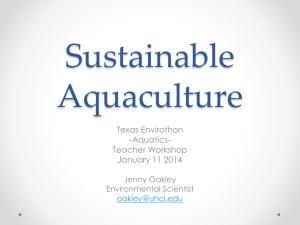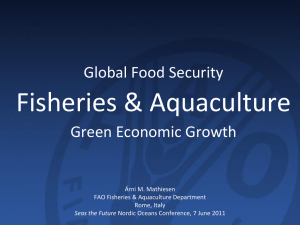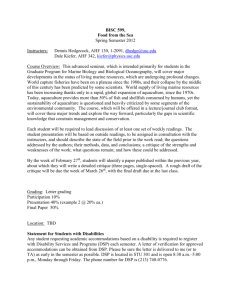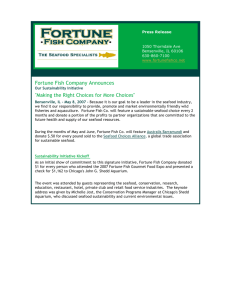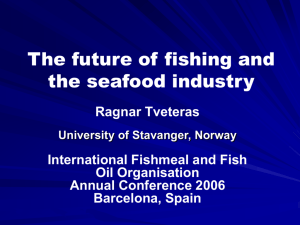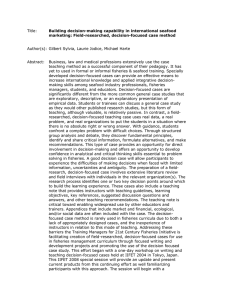Issues Fisheries - Fullerton College Staff Web Pages
advertisement
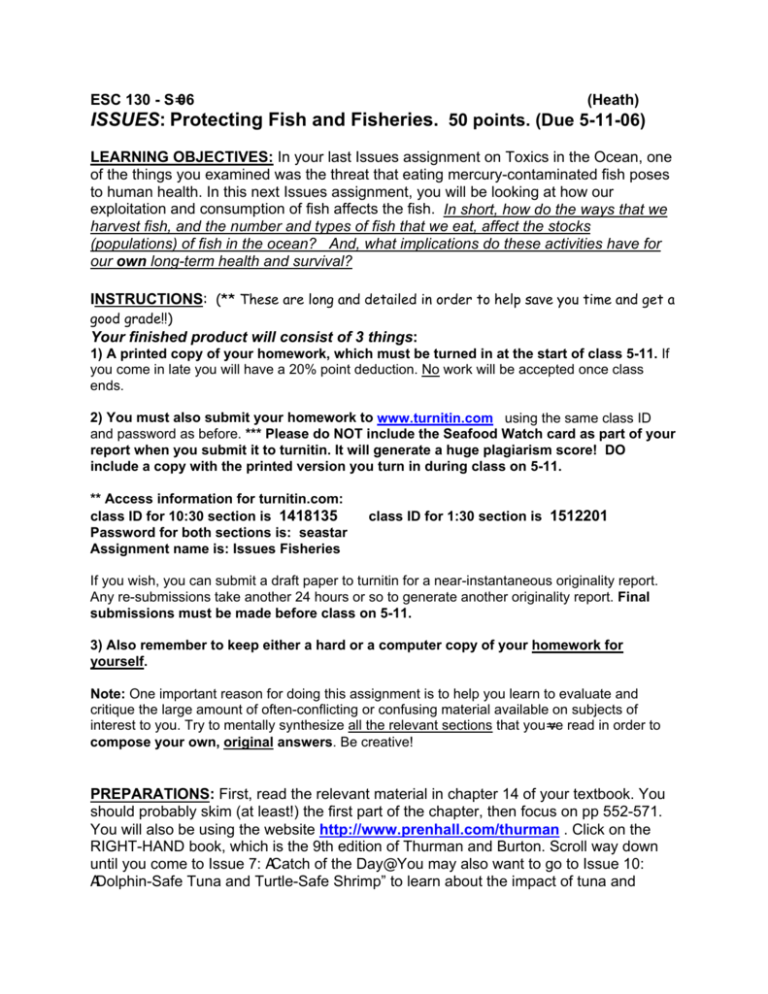
ESC 130 - S=06 (Heath) ISSUES: Protecting Fish and Fisheries. 50 points. (Due 5-11-06) LEARNING OBJECTIVES: In your last Issues assignment on Toxics in the Ocean, one of the things you examined was the threat that eating mercury-contaminated fish poses to human health. In this next Issues assignment, you will be looking at how our exploitation and consumption of fish affects the fish. In short, how do the ways that we harvest fish, and the number and types of fish that we eat, affect the stocks (populations) of fish in the ocean? And, what implications do these activities have for our own long-term health and survival? INSTRUCTIONS: (** These are long and detailed in order to help save you time and get a good grade!!) Your finished product will consist of 3 things: 1) A printed copy of your homework, which must be turned in at the start of class 5-11. If you come in late you will have a 20% point deduction. No work will be accepted once class ends. 2) You must also submit your homework to www.turnitin.com using the same class ID and password as before. *** Please do NOT include the Seafood Watch card as part of your report when you submit it to turnitin. It will generate a huge plagiarism score! DO include a copy with the printed version you turn in during class on 5-11. ** Access information for turnitin.com: class ID for 10:30 section is 1418135 Password for both sections is: seastar Assignment name is: Issues Fisheries class ID for 1:30 section is 1512201 If you wish, you can submit a draft paper to turnitin for a near-instantaneous originality report. Any re-submissions take another 24 hours or so to generate another originality report. Final submissions must be made before class on 5-11. 3) Also remember to keep either a hard or a computer copy of your homework for yourself. Note: One important reason for doing this assignment is to help you learn to evaluate and critique the large amount of often-conflicting or confusing material available on subjects of interest to you. Try to mentally synthesize all the relevant sections that you=ve read in order to compose your own, original answers. Be creative! PREPARATIONS: First, read the relevant material in chapter 14 of your textbook. You should probably skim (at least!) the first part of the chapter, then focus on pp 552-571. You will also be using the website http://www.prenhall.com/thurman . Click on the RIGHT-HAND book, which is the 9th edition of Thurman and Burton. Scroll way down until you come to Issue 7: ACatch of the Day@. You may also want to go to Issue 10: ADolphin-Safe Tuna and Turtle-Safe Shrimp” to learn about the impact of tuna and shrimp “fishing”. Much of the material presented there will help you with your assignment. (But please note: the questions you are doing differ from those at that site.) Here are some other sites you=ll be visiting, so you might want to check them out first: http://www.mbayaq.org/ http://www.lcv.org/ http://www.lcv.org/scorecard/ http://www.prenhall.com/thurman/ http://motherjones.org/news/featurex/2006/03/oceans_index.html http://www.nrdc.org/wildlife/fish **Assignment - Protecting Fish and Fisheries: consult any websites you=re sent to and answer the questions below. Please number each answer to correspond with the question. Part 1. The state of the world=s fisheries. See especially: http://www.montereybayaquarium.org/cr/cr_seafoodwatch/sfw_issues.asp AND http://motherjones.org/news/feature/2006/03/the_fate_of_the_ocean-5.html (This is one page in a great (but long) article in the March/April 2006 online AMother Jones@.) 1. What is the state of the world=s fisheries? What percentage are in decline, overfished, or ...? (I’d expect about a ¼-page answer.) 2. What are the main reasons for the current state of the fisheries? ...? (Be thorough but concise. I’d expect about ½ -> 1 page answer.) Part 2. Solutions? Aquaculture: One solution suggested to compensate for decreasing wild fish stocks is aquaculture. But is it the solution, and/or does it create problems too? Read the Issue Discussion page at http://www.prenhall.com/thurman Issue 7 (see above for how to get there). Then read Analysis 2 (link is in sidebar of the Issue Discussion). Also go to: http://www.montereybayaquarium.org/cr/cr_seafoodwatch/sfw_ac.asp Another good source is: http://motherjones.org/news/featurex/2006/03/aquaculture_faq.html Read about aquaculture at these websites. The answer the following question: 1. What is aquaculture? Explain the pro=s and con=s of aquaculture. Explain why are some types are better than others and give some specific examples! Include in your answer how shrimp farming harms the coasts, and in particular, why is it so bad for coral reefs? (about ½ page) Part 3. Solutions? Politics: Politics and politicians add another twist to solving our fisheries problems. Voting for knowledgeable and pro-environment politicians, and urging them to approve environmentally friendly legislation can be very helpful. 1. Which politician is featured in the AEnemies of the Ocean@list at http://motherjones.org/news/feature/2006/03/enemies_of_the_ocean.html ? 2. Go to http://www.lcv.org/scorecard/index.html?source=home to learn about the League Of Conservation Voters= AEnvironmental Score Card@ . 1. What do the scorecards tell you? 2. Click on ALook up your delegations= scores@ and report the scores you find for your Senators and House Representatives. What is the score for the AEnemy@ in the previous question? Part 4. Solutions? Smart Consumer Choices: To summarize the detailed instructions for #’s 1, 2a, & 2b below, you want to understand and communicate the link between YOUR diet (or a friend’s) and the state of the world’s fisheries. To do that you need to know where your food came from (as in which country or ocean, not which supermarket!), the conservation status of its wild population, and whether the fishing methods used to catch it are harmful to that population. Also note which seafood that you like to eat are also the “best choices” for the environment’s health – you can really enjoy eating them! 1. What Seafood am I Eating?? First, go to: http://www.montereybayaquarium.org Click on AChoices for Healthy Oceans@ and print two copies of the Monterey Bay Aquarium=s ASeafood Watch@ card for OUR region. This website is also an excellent source for researching the status of fish as assigned below: (see AFishy Issues@). Make a list of the seafood you eat over the next couple of days or have eaten lately. If you don=t eat seafood, then you can either survey others that do, analyze a restaurant=s menu, or list the seafood for sale at your local market. You must cover at least 4 species. PLEASE NOTE: It is NOT my intention to encourage you to go out and eat seafood you don=t normally eat! Just analyze what you or others already do eat. 2a. Where Did the Seafood Come From?? You=ll need to find the SOURCE of the seafood you or others have eaten and how it was caught. You will want to find out whether things are wild-caught or farmed, how it was caught (e.g. harpooned or drift-net or hook and line) and imported or domestic. If it=s a canned product, look carefully on the label for the country of origin, details about the product (such as albacore versus light tuna, and if it=s Adolphin-safe@). For seafood purchased at a market or restaurant, you=ll need to ASK THE SALESPERSON or SERVER to please help you find the source of the seafood, unless it=s noted on the menu or signs. Usually someone on the staff will know at least some of the answers. Otherwise you can sometimes figure it out. For example, if it=s Atlantic salmon, it=s farmed. Do the best you can. If, for example, you can=t find out where the shrimp you ate came from, then include in your answer the various ways that shrimp are harvested and discuss each method=s conservation issues as requested below. Include in your write-up the names of the people, market, and/or restaurant you surveyed. Keep your Monterey Bay Aquarium Seafood Watch card with you, and maybe even leave a copy with the people you talk to. Remember, you should have at least 4 types of seafood on your list. 2b. Next: Use the various websites to research the fishing practices used and the conservation status of each species. This is where you=ll use the information about where the fish live (e.g. Pacific or Atlantic), and where and how they were fished. Include the status of their stock/s, what, if any environmental problems are involved with the fisheries, and where they are placed on the fish-eaters= advisory lists. Present your information in a table or with well-organized writing. Helpful web sites for this section are the Monterey Bay Aquarium=s site (address above), and NRDC=s (Natural Resources Defense Council) which is: http://www.nrdc.org/wildlife/fish/default.asp (Note: FOR YOUR SUMMARIES OF FISHERIES STATUS, BE CAREFUL NOT TO PLAGIARIZE. SHORT STATEMENTS ABOUT THE SIZE, LOCATION, ETC. OF A FISHERY ARE HARD TO PUT IN YOUR OWN WORDS, SO YOU HAVE MORE FREEDOM TO COPY MATERIAL THERE, AS LONG AS IT IS PROPERLY QUOTED AND CITED. Do try to put it in your own words as much as possible, though.) Part 5. More solutions: Marine Reserves: Read the short article at: http://news.nationalgeographic.com/news/2001/12/1204_TVmarinereserves.html 1. Exactly why did the people of St. Lucia create a marine reserve? Why was there resistance to creating the reserve? In what ways was the reserve successful? 2. Marine reserves have recently been created in some areas off Southern California. What is the name and location of the large marine reserve closest to us? (Hint: see page 568 in your textbook!) Do you think these reserves are likely to help or harm fishers in: a) the short term, and b) the long term? Why? 3. Towards the end of the article, fisheries biologist Alec MacCall says that bluefin tuna and albacore might not be well protected by reserves, whereas fish such as orange roughy probably would. Explain his logic. That’s it – you are done!!





